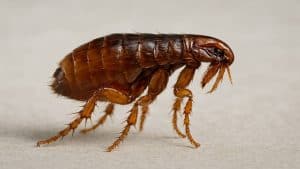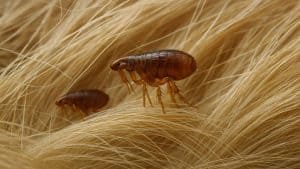Dog fleas are tiny but significant parasitic problems that can torment not only our pets but also humans. These widely spread, jumping arthropods are known carriers of various diseases.
What exactly is a dog flea?

There are numerous flea species, each with one or more preferred hosts. Not all flea species are the same, and while many can live on various animals, some fleas have adapted specifically to a particular animal species. For example:
Ctenocephalides felis
This species, often referred to as the cat flea, is actually the most common flea that infests not only cats but also dogs, humans, and other mammals. The adaptability and survival ability of Ctenocephalides felis on various hosts explain why it is a global problem.
Ctenocephalides canis
The dog flea also occurs on dogs but is less common than the cat flea. This species primarily lives on dogs but can be found on other animals too.
Pulex irritans
The human flea, which can infest humans, pigs, and other animals. This species used to be more common but is now rare, partly due to improved hygiene and widespread use of flea control treatments.
Echidnophaga gallinacea
The sticktight flea primarily lives on poultry but can infest other animals, including dogs, cats, and humans, if they are near infested birds.
These examples show that while many flea species exist, not all can live or reproduce equally well on all animals. The host preference of fleas is an evolutionary adaptation that allows them to thrive on specific animal species but also accept other hosts if necessary. This host specificity sometimes limits flea spread between different animal species, but the most widespread flea species, like Ctenocephalides felis, are highly adaptable and can live on a wide range of hosts.
Dog Flea: Reproduction and Lifecycle
The flea lifecycle consists of four stages: egg, larva, pupa, and adult. A female flea can lay up to 50 eggs a day, which fall off the dog and scatter in the environment. These eggs hatch into larvae, which then develop into pupae. The pupae eventually hatch into adult fleas when they find a host, thus completing the lifecycle. This entire process can occur in as little as 2-3 weeks under favorable conditions.
Flea Eggs
Dog flea eggs usually hatch within 2-14 days, depending greatly on environmental conditions. Under ideal conditions with high humidity and warm temperatures, the eggs hatch faster. However, in a dry and cold environment, the eggs can survive and delay hatching for weeks or even months.
How long can a flea egg survive?
The lifespan of flea eggs and the infectivity of a previously flea-infested area can vary depending on environmental conditions. Temperature, humidity, and the availability of food for larvae all influence the survival of flea eggs, larvae, and pupae.
Flea Larvae
Upon hatching from the eggs, larvae develop into pupae within 5-20 days, depending on food availability and environmental conditions. Larvae prefer dark, moist places and feed on the feces of adult fleas, which contain blood residues.
Flea Pupae
The pupal stage is the most resistant phase in the flea lifecycle. A flea can emerge from the pupal cocoon in a few days if conditions are favorable, but it can also survive for months or even up to a year if necessary until it senses suitable conditions (such as the presence of a host animal, indicated by temperature, carbon dioxide, or vibrations) to hatch.
Flea Control
Flea control involves various methods, from simple preventive measures to chemical treatments. Regular bathing and grooming can help detect and remove fleas early, while cleaning and treating the environment (such as bedding and resting areas) can reduce the likelihood of flea population buildup.
Dog Flea Treatments
- Spot-on treatments: These liquids are applied directly to the animal’s skin. They are effective but may cause irritation in some cases.
- Flea collars: Provide long-term solutions but not all dogs tolerate them well, and they can occasionally cause skin irritation.
- Oral flea medications: Act quickly and can provide protection for one to three months. Side effects are rare but can occur.
- Flea shampoos and sprays: Provide immediate relief but have a shorter duration of effect and require regular application.
For any treatment, veterinary advice is crucial, as some products may not be suitable for all animals, and interactions with other medications or health conditions can complicate matters. Flea treatments should be performed several times a year, as recommended by the veterinarian.
How long can a previously flea-infested area remain infectious?

To prevent reinfestation, thorough cleaning, vacuuming, and treatments that interrupt all stages of the flea lifecycle are necessary, including environmental treatments like flea sprays on carpets, furniture, and pet resting areas.
Diseases Caused by Dog Fleas
Fleas not only cause discomfort with itching and skin irritation but can also be sources of more serious health problems, including:
- Flea allergy dermatitis: The most common allergic reaction in dogs, caused by hypersensitivity to flea saliva allergens, resulting in intense itching and skin inflammation, potentially leading to secondary infections.
- Tapeworms: Particularly problematic for young animals, as fleas are intermediate hosts for tapeworm larvae. When a dog ingests an infected flea, it can contract tapeworms.
- Hemoplasmosis: A disease caused by microorganisms that fleas can transmit, attacking the animal’s red blood cells and causing anemia.
- Bartonellosis: Often called “cat scratch fever,” primarily spread by cats but can occur in dogs via flea transmission, causing fever, fatigue, and possibly joint inflammation.
Treating Dog Fleas
Treating a flea infestation in a household with dogs involves vacuuming, mopping, and treating the dog, but often additional measures are necessary for a complete solution. Given the complexities of the flea lifecycle—including eggs, larvae, pupae, and adults—completely eradicating them can be challenging. Here are some additional steps and considerations for treating a flea infestation:
Environmental Treatment
- Vacuuming: Effectively removes flea eggs, larvae, and some pupae from carpets, furniture, and cracks. Ensure to empty or dispose of the vacuum bag or canister immediately after use to prevent fleas from spreading further.
- Hot steam cleaning: Helps kill flea eggs and larvae on carpets and furniture.
- Flea control products: Environmental flea control products like sprays and powders can help disrupt the flea lifecycle. Choose a product safe for household use and follow the instructions carefully.
Animal Treatment
- Use one of the previously mentioned flea treatments (spot-on, tablets, collars, shampoos, ultrasonic devices).
- Continuous Monitoring and Regular Checks
- Regular checks and treatments for both the dog and the household are necessary, as reinfestation can occur due to the flea lifecycle.
Additional Important Steps
- Treat all pets: If there are multiple pets in the household, treat all of them for fleas, even if only one is showing signs of infestation.
- Repeat environmental treatment: Given the flea lifecycle, environmental treatments may need to be repeated after a few weeks to ensure complete eradication.
Combining the above steps and measures increases the chances of fully and effectively eliminating a flea infestation, preventing future recurrences.
When selecting flea control products recommended by a veterinarian, consider the dog’s age, health status, weight, and any potential interactions with other medications. Don’t forget to treat the environment as well, as interrupting the flea lifecycle is crucial in preventing infection.
Fighting dog fleas requires continuous attention and preventive measures. Knowing the various control methods and treatments, along with following veterinary advice, helps maintain our pets’ health and well-being. Remember, flea-borne diseases can affect not only dogs but also humans, so flea control efforts protect both our animals and ourselves.
For more valuable content, check out our articles on living with dogs, dog sports, or dog diseases. Or read about the problems caused by foxtails in dogs.


